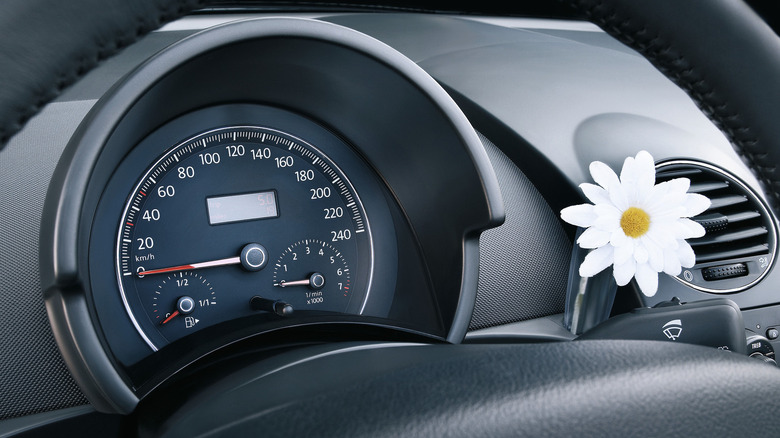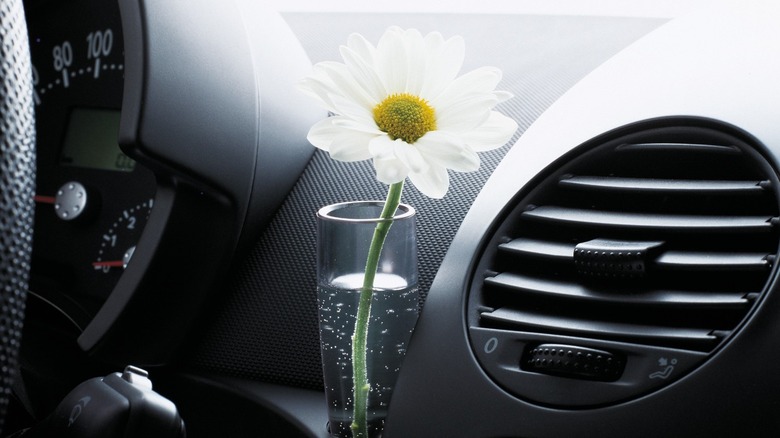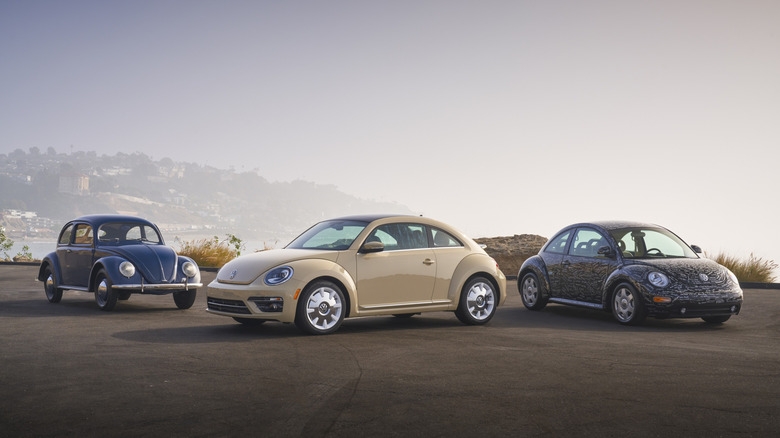The Volkswagen Beetle Once Came With A Feature That No Other Car Had
The Volkswagen Beetle is one of the most iconic vehicles in history. From its massive global sales figures to its 57-year production run, it truly realized Volkswagen's original mission (and the company's namesake) of delivering a "people's car" not just to Germany, but to the world.
However, it wasn't just the Beetle's affordable price and straightforward mechanics that won over millions of car buyers across the world. The Beetle also had more than its fair share of interesting personality traits and features over the years, and they've helped give the car an enduring appeal that goes far beyond just filling one's need for basic transportation. Volkswagen put a lot of effort into capturing these traits when developing its modern reinterpretation of the Beetle in the 1990s.
When it comes to the New Beetle's most interesting features, there's one in particular that's come to define the car: the flower vase on the dashboard. Let's dig into how this small but memorable automotive accessory got its start and how it became such a famous part of both the original Beetle's and the New Beetle's interior.
The original car air freshener
The initial use of a flower vase in an automobile predated the Beetle by quite some time, tracing its origins back to the earliest days of motoring in the late 1800s. And those early drivers didn't put flowers in their cars just because they looked pretty. They were used as natural air fresheners to mask the scents of exhaust and oil, as well as the smells of the car's occupants in an era before air conditioning and modern automotive ventilation.
By the time the glass vase made its way to the Beetle as a dealer accessory in the 1950s, it had become a bit more of a fashion statement, clipped to the dashboard and filled with whichever flowers (real or fake) the owner desired. Perhaps not coincidentally, by the mid-1960s, the Beetle, along with the Volkswagen Bus, had become a car that was synonymous with the "flower power" movement.
Fast forward another 30 years to the debut of the Volkswagen New Beetle. Though it used a front-engine, water-cooled platform and powertrain borrowed from the Golf, the New Beetle was heavy on retro elements both inside and out. And those included a dash-mounted flower vase (now acrylic rather than glass) as standard equipment.
A Beetle tradition
In the late '90s and early 2000s, the New Beetle was a hot commodity. An incredible 80,000 examples were sold in America for the 1999 model year. The vase became a great conversation piece and likely helped with the New Beetle's popularity among women, who, according to Volkswagen, made up 60% of the car's buyers.
The New Beetle was replaced by the more simplified "Beetle" for the 2011 model year, and though the second generation continued with plenty of retro charm, the vase was no longer part of the package. This was partly for functional reasons and partly because Volkswagen was hoping to give the car a more gender-neutral personality. The Beetle lasted until the 2019 model year before being axed as part of the industry-wide shift away from small cars and toward crossover SUVs.
With Volkswagen digging into its heritage for the stylish new ID. Buzz electric van, there are rumors and wishes for a new retro-themed Beetle, this time as a city-friendly electric car. Volkswagen has already debuted an inexpensive EV for other markets called the ID.EVERY1, but it doesn't have much in the way of heritage cues. We can't help but think that a properly bulbous, retro-inspired Beetle EV with a reasonable price tag would be an ideal complement to the fashionable, but pricey ID. Buzz. And if Volkswagen were to entertain those wishes, it isn't a stretch to think that the iconic dash-mounted flower vase could again be part of the package.


